25 years of exoplanet hunting hasn't revealed Earth 2.0 — but is that what we're looking for?
Even this extremely long article hasn't scratched the surface of humanity's exoplanet revolution.
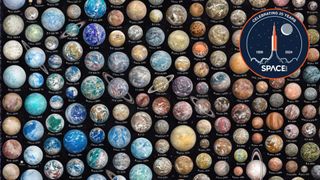
When Space.com opened its doors to the world on July 20, 1999, humanity knew about fewer than 30 exoplanets. Today, as you read this article, that number shoots well beyond 5,000.
If you'd believe it, the first worlds beyond our own were confirmed only about seven years before this website's first article was christened; they were orbs anchored around a spinning neutron star named PSR B1257+12 (more on that in a moment). As for the headline of our first article, however? Well, we may never know. It would appear it was lost to time — a mysterious server fire destroyed our records of it, and The Wayback Machine is not coming to our rescue. If anyone can locate it, you know where to find me.
Before we get into how those extraterrestrial tens turned into thousands, there's another way to put the exquisitely short timeline of exoplanet research into perspective. Consider how July 20, 1999, was also the 30th anniversary of NASA's Apollo 11 launch. That means before identifying a concrete planet outside our solar system, scientists hadn't only managed to send humans to space, but had even landed people on the moon six times. When Neil Armstrong stepped onto the lunar surface, he did it while believing our cosmic suburbia's nine planets (poor Pluto was still an official planet then) might be the only ones out there.
Related: The 10 most Earth-like exoplanets
It was as though all the exoplanets needed a couple of brave guinea pig worlds to prove the coast is clear, because, after 1992, they started popping up all over the place.
Check out a list of Space.com's special 25th anniversary week stories in our hub linked here!
"I think exoplanet research is related to the first questions that come to an inquisitive human mind: How did the Earth form? How did the solar system form? Is there life out there? Is the solar system unique to harbor life? Without having answers to these first questions, I think our understanding of the universe wouldn't be complete," Naman Bajaj, a scientist with the University of Arizona's Lunar and Planetary Science Laboratory, told Space.com.
Now, let's quickly return to that neutron star situation. Though a lot has happened over the past decades in the realm of alien worlds, the beginning years are probably the heaviest, and the most important.
Get the Space.com Newsletter
Breaking space news, the latest updates on rocket launches, skywatching events and more!
A modern space revolution
Neutron stars — aka, the type of objects around which the first exoplanet was discovered — are wild.
They're the remnants of stars that, once upon a time, died explosive supernova deaths. And, after their destruction, all the matter contained within those stars would've compressed to such a degree that the majority of bits left behind were swarms of neutrons. Barely any protons; barely any electrons.
And this kind of neutron-only material is incredibly dense. Like, I cannot overstate that density. Moreover, PSR B1257+12 isn't just a normal neutron star. It's a spinning one, also known as a pulsar. So, clearly, those first couple of 1992 exoplanets couldn't be anything like Earth. Actually, in 1994, scientists further complicated that scene by realizing the pulsar is part of a binary that includes a white dwarf star as well as … another exoplanet. In 1995, however, things started getting more relatable.
Related: In the last 25 years, black hole physicists have uncovered the unimaginable
That's when astronomers Didier Queloz and Michel Mayor announced they'd discovered the first exoplanet around a main-sequence star. About 90% of the universe's stars are believed to be main-sequence ones, including our sun, so this was a big deal. The subject was named 51 Pegasi b. It sits approximately 48 light-years from us, is a gas giant similar in concept to Jupiter but with about half its mass, and orbits its star, 51 Pegasi, once every 4.2 Earth days. "I think the first class of exoplanets discovered around sun-like stars are the most fascinating ones," Bajaj said. "They are called hot Jupiters, as they are Jupiter-mass planets but orbit their host star very close-in, and are therefore hot!"
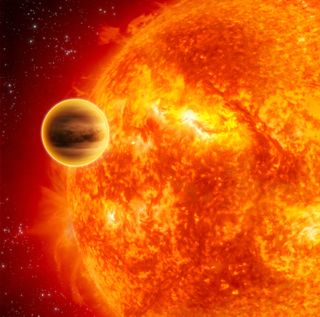
As Bajaj explains, after 1995, scientists started identifying quite a few of these hot Jupiters in particular. For instance, 1996 was the year of the mauve-striped 47 Ursae Majoris b, and 1998 belongs to the candyfloss-colored GJ 876 b. "It challenged our understanding of planetary system architecture," he said, "because, looking at the solar system, we always thought that the small rocky planets end up in the inner parts and big gas planets in the outer region."
Well, okay. So, here's the thing about that. Astronomers soon realized something weird about all the scorching gas giant data.
The detection mechanism used at the time, Bajaj says, was revealed as biased toward finding this exact class of exoplanet. Imagine being tasked with finding as many flowers as possible in the woods, but wearing glasses that only allow you to see the color red. You'd probably haul in a bunch of red flowers, even if the majority of flowers in this forest are expected to be pink. It's the same idea. Indeed, it remains an ongoing question how exactly those majestic gas planets formed so strangely close to their star.
On the bright side, having revealed this bias, things began to shape up.
And soon, Space.com could finally chime in.
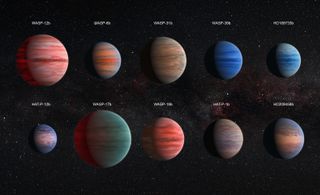
The Space.com planet party
The year is 1999. Space.com exists at last, and, man, what a time to come onto the scene.
Right around then, a new method of exoplanet detection began gaining traction. It's called the transit method, and is still as golden today as it was when it led to its seminal discovery about 25 years ago. You know how, during a solar eclipse, the moon crosses between our planet and our star, making daylight fade into dusk? Picture that, except on an extremely small scale. Sometimes, a distant exoplanet crosses between its host star and our detectors on Earth, procuring a baby dip in starlight. That's what the transit method refers to.
The first transiting exoplanet to be found was the stony-hued HD 209458 b, but that was actually still a pretty blistering gas giant. It wasn't until 2011 when the Kepler Space Telescope found its first-ever rocky world, named Kepler-10, through this method. But, I digress.
Very quickly, our website's writers dedicated to celebrating and investigating the thrill of space exploration would start churning out articles of these discoveries. (I was still three years old in 1999, to be clear, but I'm blessed with access to Google.)
A 2004 story writes about two newly found Neptune-size worlds, one of which is even dubbed a "super-Earth," meaning it's bigger than our planet but lighter than an ice giant like Neptune. A parallel story from the same year explains the discovery of the first exoplanet to be found with a "backyard telescope," and a 2006 piece wonderfully talks about the first multi-exoplanet system ever confirmed, Upsilon Andromedae, opening with a nod to Robert Frost.
"Being in such a young field makes every discovery feel like it's got a large impact," Keighley Rockliffe, an exoplanet researcher at Dartmouth College, told Space.com. "I think the most important discovery is the ubiquity of exoplanets — they are everywhere! Half of all stars like the sun have exoplanets around them. And to think that just about 30 years ago we weren't even sure if they existed at all."
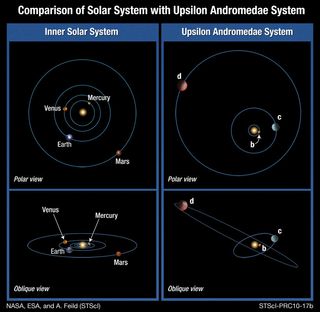
Which brings us to 2009, when our next special milestone falls: The launch of the aforementioned Kepler Space Telescope. This was NASA's first mission physically dedicated to the hunt for planets beyond our solar system. With a price tag of $600 million, it held the largest digital camera formatted for space exploration at that time, one of the largest mirrors to go beyond Earth orbit and was built to monitor about 100,000 main sequence stars over three-and-a-half years in search of some juicy exoplanets.
Sure enough, in its first six weeks of operation, Kepler had already found five. Imagine that! For the majority of human existence, no one knew there were any exoplanets at all. Then, in just over a month, a single observatory found five.
Before ending its mission in 2018, Kepler had added 2,662 worlds to the exoplanet catalog — and many of those discoveries were, in fact, very instrumental in pushing the field forward. In 2014, Kepler helped scientists confirm the existence of an Earth-size exoplanet in the habitable zone of its star for the first time — in reference to the region around a star where it isn't too hot nor too cold for a world to potentially host liquid water — and in 2016, it found Proxima b, an exoplanet that sits remarkably close to us. Proxima b appears to be in its star's habitable zone, too, which makes that result doubly exciting.
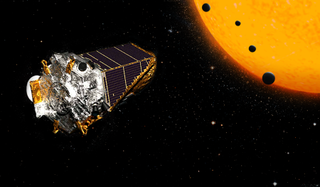
Big picture-wise, NASA calls Kepler key in cementing concepts like the fact there are more planets than stars in our galaxy and that 20% to 50% of the stars in the sky are likely to have "small, possibly rocky planets similar in size to Earth within the habitable zone of their parent stars — where water could pool on the planet surface." What a thought-provoking statement.
"We are still in the regime where we need the detection of a wide variety of exoplanets that we haven't discovered yet, including the habitable zone planets," Bajaj said. "Following that, I think the upcoming Nancy Grace Roman Space Observatory would be the next big event in the exoplanet community. The Ariel Space Mission would probably play that same role for the studies of their atmospheres."
"I'm excited about the Nancy Roman Space Telescope," Rockliffe agreed, referring to the exquisite observatory currently being built with the help of futuristic AR technology, slated to launch in 2027. "It will have the capability to detect exoplanets through the microlensing technique."
Unlike the transit method, the microlensing technique is one in which a star and its planet system cross in between our telescopes and a second, background star. Thanks to a little bit of general relativity drama, the star-planet system's mass warps the very fabric of space and time slightly, thereby forcing the background starlight to bend on its way to our detectors. It's called gravitational lensing, or in this case, "microlensing."
"This technique is sensitive to planet properties we haven't been able to probe yet with transits and radial velocities," Rockliffe said. (The radial velocity method has to do with these things called "wobbles.")
"For example, we'll finally be able to detect solar system gas giant analogs — colder than the gas giants we've been detecting so far — and we'll be able to detect planet masses as small as Titan, Saturn's largest moon," she said. "Maybe we'll finally start seeing some stellar systems that look like our own solar system!"
Alas, let's return to our exoplanet timeline.
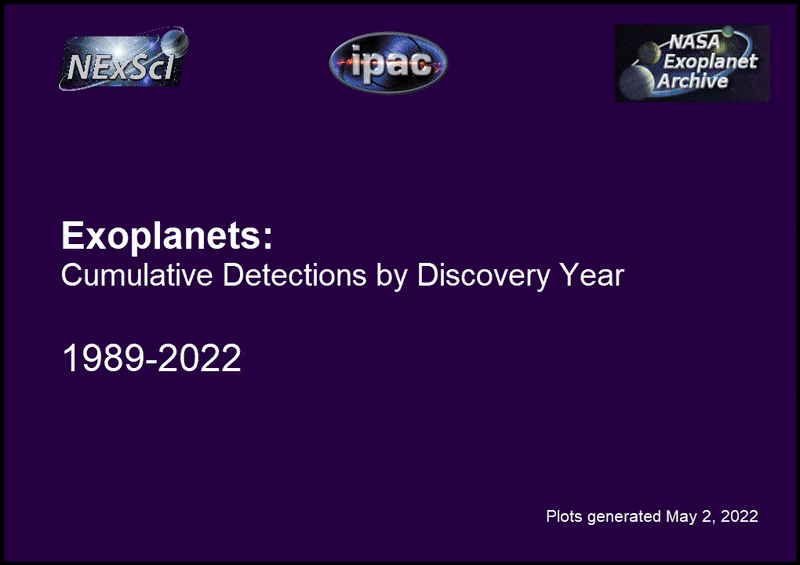
As we get closer to the present, the hits just keep on coming. But in 2017, something huge happened: Scientists found what has become almost the Holy Grail of extraterrestrial research. It's called Trappist-1.
Trappist-1, in short, is quite a mind-bending system to think about. It's a planetary crew about 40 light-years away that orbits a red dwarf star — and it involves seven Earth-like planets. Though there's still much debate about this, especially because the James Webb Space Telescope's incredible precision is helping scientists enhance their planet-hunting concepts — it is considered one of our best leads in the quest to find life elsewhere in the universe. Massive amounts of research have been focused on Trappist-1 specifically, for this reason.
This is probably a good time to take a pause and recall where we were at the beginning of this story: in an epoch of human history during which humans believed our solar system's planets could, theoretically, be all alone.
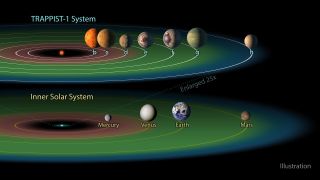
At this point, you may have noticed a trend starting to appear. Scientists have successfully started the ever-intensifying exoplanet party, learning that worlds beyond our own certainly exist out there. So, was it time to begin narrowing the search somehow?
Was it time to find another Earth?
Where is Earth 2.0?
One of the most peculiar things about searching for another Earth is defining the word "Earth."
Are we talking about a blue planet with tectonic plates, various biomes and a wealth of intelligent species? Or, are we talking about any planet with oceans of liquid water and the correct levels of nitrogen and oxygen in the air such that we can breathe there? Or, are we simply talking about an exoplanet about the size of our planet?
Depending on your definition, it may be that we already found your Earth 2.0.
"I assume an Earth-size planet in the habitable zone, where there will be liquid water but may or may not harbor life," Bajaj said. "So far, we have found small and big planets close to the star through transit and radial velocity methods, and big planets far away from the star have been found through direct imaging, following their biases."
"Exoplanet science is so young and we're still in the stage where we're learning the right questions to ask. Maybe it isn't 'is there another Earth?' but rather 'what combination of measurements can convince us that a planet is suitable for life?' regardless of whether it seems Earth-like or not," Rockliffe said.
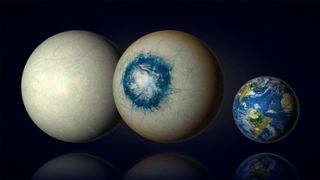
However, if your definition of Earth 2.0 is a world in which intelligent life lurks, experiencing day and night the way we do with little variations (like an alternate reality of some sort) that's a fully different discussion.
There's this longstanding conundrum surrounding life in the universe known as The Fermi Paradox. The entire concept is quite complex and impressive, but the nutshell version is that it is peculiar, simply based on probability, that we haven't made contact with alien life yet. If there is indeed such a vast amount of stars and exoplanets — on scales our mind cannot comprehend — it's strange that not one world led to life in the way Earth did. Or, at least, in a similar way. Wouldn't they have found us? Wouldn't we have found them? So, the paradox puts forth, what are some variables that would prevent us from finding intelligent life?
Rockliffe invokes an idea discussed in the book series (and now TV show) "Three Body Problem," written by Cixin Liu.
(Very mild spoilers ahead, so be wary if you're in the middle of the series.)
Liu, Rockliffe says, addresses the Fermi Paradox through a concept in the series called the "Dark Forest," which actually existed before the book: "It's a description of sociology on astronomical length scales. If life exists elsewhere in the Milky Way and it has the technology to communicate, they will remain silent and 'dark' to us."
The reason for this is that the distance between potential life-bearing stellar systems is so great that light, the fastest form of communication, would take years to traverse it. "It is therefore impossible to know and understand the motives of another civilization," she explained, adding how the Dark Forest concept suggests that, for a civilization to survive, they'd need to assume other civilizations are hostile and therefore remain "dark" to the galaxy. "I think this is incredibly fascinating and the beauty of it is that there is room for creativity," she said. "It's required to think outside of the box on this one."
(Spoilers are done now)
"I firmly believe that we can detect another Earth," Bajaj said, "but technology takes time to build."
"If we look at it from a human-centric point of view, then everything happened in the universe to eventually form life," he said, suggesting the timeline of time itself can be divided into four big blocks: The Big Bang, the creation of galaxies, the creation of our solar system including Earth and, finally, life. "Exoplanet research is addressing the third block of this grand scheme."
Weird, surreal and impossible worlds
We left off in 2017, with the tantalizing detection of Trappist-1, and you may not have realized it yet, but that was a cliffhanger. Well, if you've read this far, you probably do know where I'm going with this.
In 2018, arguably the most famous alien-world-finder ever launched: NASA's Transiting Exoplanet Survey Satellite. You may know it as simply "TESS." And, yes, 2018 is also poetically the same year Kepler shut down after carving out a brilliant legacy for itself.
Though TESS has indeed identified some of those intriguing sort of Earth doppelgangers (again, depending on your definition), I would argue that its greatest discoveries are of the worlds that don't look like our home. The scary ones; the massive ones; ones similar to that diamond one that regrows its atmosphere like cockroaches grow limbs and the one half-covered in lava like a parody of partial hell.
To put TESS' own legacy into perspective, the exoplanet counter hit 4,000 in 2019, then hit 5,000 in 2020. One time, TESS data and Keck Observatory data caught 126 worlds in one go. Even citizen scientists have joined forces with TESS to unlock the next stage of what will one day be iconic exoplanet history and, every so often, TESS churns out a non-exoplanet discovery as well. See: Comet Burp.
However, a lot of exoplanet research goes beyond the sheer volume of worlds discovered. The nuances are just as crucial for the field. For instance, TESS has found six exoplanets around a "misbehaving," relatively toddler-age star and potentially its first rogue world recently, which is a planet that roams the universe all alone without a parent star.
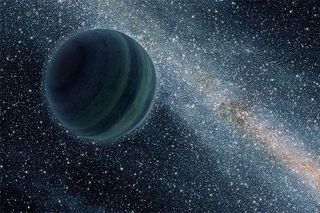
Rockliffe herself also led a team that used Hubble Space Telescope observations to analyze a star absolutely eviscerating its exoplanet about 32 light-years away from us. The planet, named AU Mic b, seemed to be losing its atmosphere at the hands of this star at a weirdly variable rate.
"It was certainly an unexpected result as no other planet has shown that level of variation in planetary outflow detection," she said. "Planetary outflows in general are pretty cool because they are thought to be deeply impactful on how an exoplanet evolves over time."
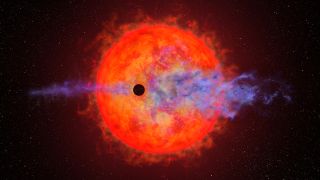
Bajaj, on the other hand, used the James Webb Space Telescope's powerful eye on the cosmic expanse to determine how long gas giants have to form before all the gas around their star fades away. The short answer is: not very long!
"On the grandiose scale of the universe, exoplanets are not even a grain of sand," Rockliffe said. "In a physical sense, they aren't vital to understanding the universe as a whole. However, planets are the astronomical objects that people, non-scientists and scientists alike, can relate to the most. They aren't extremely hot or bright or huge in ways that the human mind can't even imagine but actually sit near the edges of comprehension."
"I think that is incredibly important for any field of science; we need to be able to connect with what we are studying."
Join our Space Forums to keep talking space on the latest missions, night sky and more! And if you have a news tip, correction or comment, let us know at: community@space.com.

Monisha Ravisetti is Space.com's Astronomy Editor. She covers black holes, star explosions, gravitational waves, exoplanet discoveries and other enigmas hidden across the fabric of space and time. Previously, she was a science writer at CNET, and before that, reported for The Academic Times. Prior to becoming a writer, she was an immunology researcher at Weill Cornell Medical Center in New York. She graduated from New York University in 2018 with a B.A. in philosophy, physics and chemistry. She spends too much time playing online chess. Her favorite planet is Earth.
-
F1NNRJ6805 I just came here to point out that i am pretty sure you got "Tess" wrong, in your article you state that it is 'Transiting Exoplanet Survey Telescope', when it actually stands for 'Transiting Exoplanet Survey Satellite'.Reply -
rod An interesting report. I note TESS info in it. "Though TESS has indeed identified some of those intriguing sort of Earth doppelgangers (again, depending on your definition), I would argue that its greatest discoveries are of the worlds that don't look like our home. The scary ones; the massive ones; ones similar to that diamond one that regrows its atmosphere like cockroaches grow heads and the one half-covered in lava like a parody of partial hell. To put TESS' own legacy into perspective, the exoplanet counter hit 4,000 in 2019, then hit 5,000 in 2020. One time, TESS data and Keck Observatory data caught 126 worlds in one go. Even citizen scientists have joined forces with TESS to unlock the next stage of what will one day be iconic exoplanet history and, every so often, TESS churns out a non-exoplanet discovery as well. See: Comet Burp."Reply
The NASA archive sites shows all confirmed TESS, presently 491 today, https://exoplanetarchive.ipac.caltech.edu/index.html
MS descriptive stats show min a = 0.00622, max a = 1.152, TESS is finding exoplanets inside 1.2 au distance from the parent stars in the confirmed list. The mean size is near 5.8 earth radii (478 show earth radii size), so most are large exoplanets. This site is exploding now in exoplanet counts, https://exoplanet.eu/home/
I am still waiting to see confirmation in science that non-living matter evolved on exoplanets into life, eventually evolving into ET phoning home with abundant plant life too on ET home world :) -
MR_Space Reply
You are correct, that was certainly a blunder. Thank you for pointing this out.F1NNRJ6805 said:I just came here to point out that i am pretty sure you got "Tess" wrong, in your article you state that it is 'Transiting Exoplanet Survey Telescope', when what it actually stands for a Transiting Exoplanet Survey Satellite'. -
rod This site shows 7020 confirmed exoplanets today, https://exoplanet.eu/home/Reply
That is a bunch now for exoplanet studies. I note those listed with radii 1.1 or less earth size are 323 in the list. Min size 0.0000224 earth radii, max 1.098482 earth radii. Average size =0.88587 earth radii.
Average or mean mass = 16.117 earth masses. The min = 0.0603858 earth mass and max = 651.531 earth masses. -
space fan Of course Earth 2.0 as of yet hasn't been found. How many planets are there in the milky way? Thats a lot to sift through. Just have to keep looking. Eventually something will be discovered and when it is that will be a milestone like no other for humanity. For now I'm just hoping the trip to Europa reveals something astounding.Reply -
Helio Reply
You might enjoy looking at the current list of potential Earth 2.0 exoplanets:space fan said:Of course Earth 2.0 as of yet hasn't been found. How many planets are there in the milky way? Thats a lot to sift through. Just have to keep looking. Eventually something will be discovered and when it is that will be a milestone like no other for humanity. For now I'm just hoping the trip to Europa reveals something astounding.
https://forums.space.com/threads/exoplanet-stats.53633/post-603703